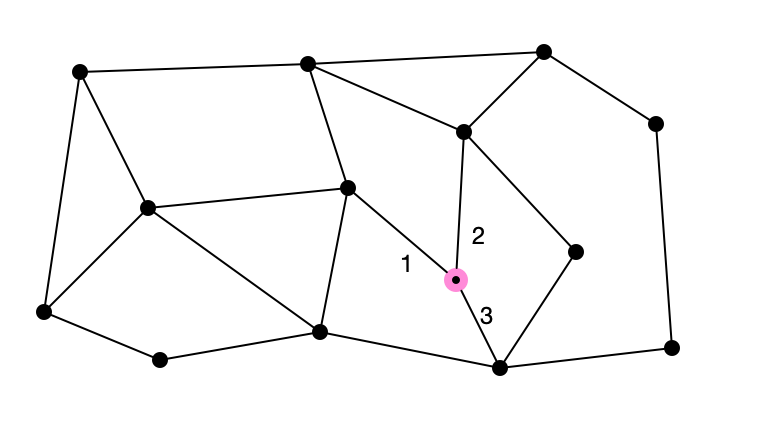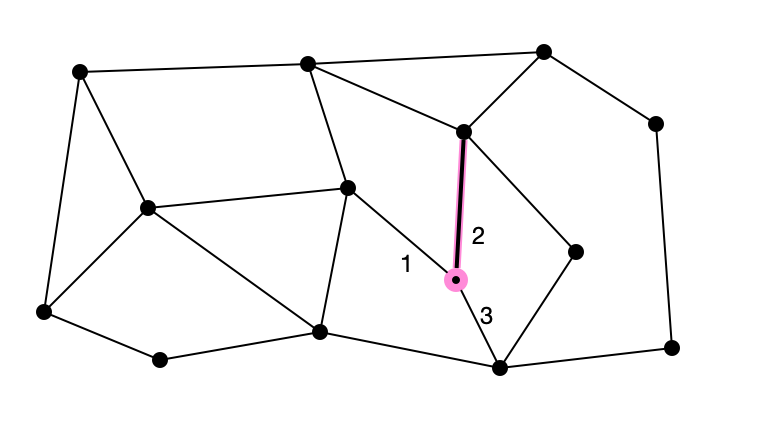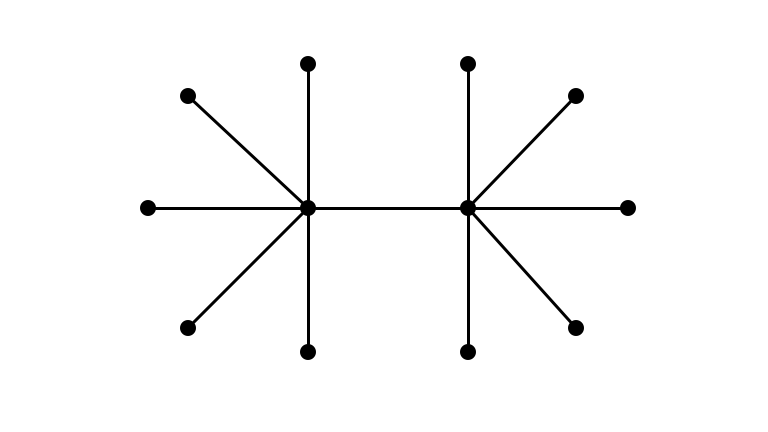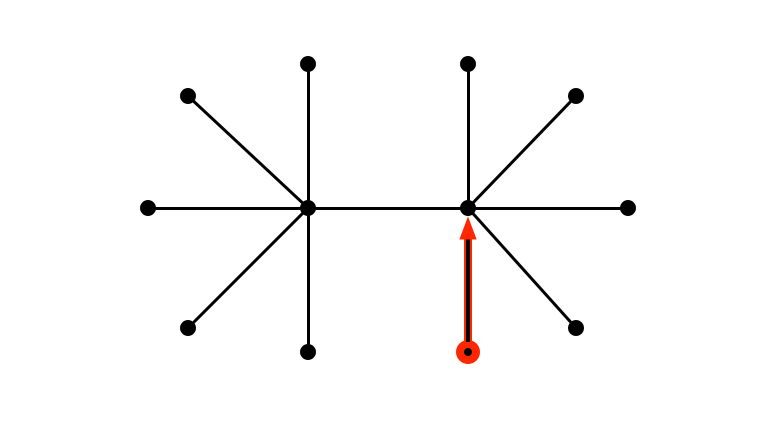Sampling Edges and More
Will Rosenbaum
Amherst College
Outline
- Introductory Remarks
- Sampling Edges: A Simple Algorithm
- Optimality?
- Parameterization by Arboricity
- Applications and Open Questions
About Me
Assistant Professor in CS at Amherst College
Previously:
- Postdocs at MPI for Informatics in Saarbrücken, Germany and Tel Aviv University
- Grad at UCLA (Math)
Generally interested in CS Theory: algorithms and complexity
- role of communication and locality in algorithms
- local and distributed algorithms
- sub-linear algorithms
- algorithms with uncertainty about input
A Large(?) Graph

Goal: Sample a Random Edge

Problem: Don’t Initially Know Edges

Computational Model
- $G = (V, E)$ a very large graph
- access to $G$ provided via queries:
- sample a (uniformly random) vertex $v \in V$
- degree query: return the degree of vertex, $d(v)$
- neighbor query: return the $i$-th neighbor of $v$
- pair query: return whether or not $(u, v) \in E$
A.k.a. general graph model in property testing
Problem Statement
Goal. Sample an edge $e \in E$ from an almost uniform distribution.
- use as few queries as possible
Point-wise Uniformity. Want every edge $e$ to be sampled with probability
- $\Pr(e \text{ is sampled}) = \frac{(1 \pm \varepsilon)}{m}$
where $m$ is number of edges.
2. Sampling Edges: A Simple Algorithm
Warm-Up
What if an upper bound $\Delta$ on maximum degree is known?
- pick vertex $v$ uniformly at random
- pick a number $i$ from ${1, 2, \ldots, \Delta}$ uniformly at random
- query $i$th neighbor of $v$
- if a vertex $w$ is found, return $e = (v, w)$
- otherwise, go to step 1
A Graph with $\Delta = 4$

Pick a Random Vertex

Pick a Random Number \(\leq \Delta\): 3

Failure. Try Again!

Pick a Random Vertex

Pick a Random Number $\leq \Delta$: 2

Return Selected Edge

Simple Algorithm
What if an upper bound $\Delta$ on maximum degree is known?
- pick vertex $v$ uniformly at random
- pick a number $i$ from ${1, 2, \ldots, \Delta}$ uniformly at random
- query $i$th neighbor of $v$
- if a vertex $w$ is found, return $e = (v, w)$
- otherwise, go to step 1
Claim 1. Each edge sampled with probability $\frac{2}{n \cdot \Delta}$.
Claim 2. Expected number of queries until success is $O\left(\frac{n \cdot \Delta}{m}\right)$.
Question 1
Claim 2. Expected number of queries until success is $O\left(\frac{n \cdot \Delta}{m}\right)$.
For what graphs is this algorithm efficient?
Question 2
Claim 2. Expected number of queries until success is $O\left(\frac{n \cdot \Delta}{m}\right)$.
What if there is no (known) upper bound on maximum degree?
More Questions
Can we do better…
…when no bound on $\Delta$ is known?
…when $n \Delta / m$ is large?
Main Question. For what (families of) graphs can we sample edges efficiently?
- What promises ensure efficient edge sampling?
An Illustrative Example

Observe

- $\Delta = \Theta(n)$
- $m = \Theta(n)$
- $\implies n \Delta / m = \Theta(n)$
- can always sample with $\Theta(n)$ queries
- get degrees of all vertices
Leaf Edges are Easy to Sample

See Middle Edge w/ Prob \(\Omega(1/n)\)?

Access Middle Vertices via Neighbors

Access Middle Vertices via Neighbors

Generalizing the Procedure
- partition vertices according to degree
- use threshold $\theta$
- if $d(v) \leq \theta$, $v$ is light
- if $d(v) > \theta$, $v$ is heavy
- sample edges from light vertices as in warm-up
- to sample edges from heavy vertices:
- sample an edge $(u, v)$ with $u$ light
- if $v$ is heavy, pick a random neighbor $w$
- return $(v, w)$
Technicalities

Edges \(\to\) Oriented Pair of Edges

Partition Vertices into Heavy/Light

Partition Edges into Heavy/Light

Another View

To Sample Light Edge

1. Sample Vertex; Check Light

2. Pick Random \(i \leq \theta\)

3. Return \(i\)th Edge (or Fail)

To Sample Heavy Edge

1. Sample Light Edge \((u, v)\)

2. If \(v\) is Light, Fail

3. Otherwise, Pick Random Neighbor

Choosing Threshold \(\theta\)
Want:
- $\theta$ as small as possible
- want light edge sampling to succeed
- every heavy vertex has mostly light neighbors
- can reach every heavy vertex in one step from light
- hit each heavy vertex with prob. proportional to its degree
A Good $\theta$
Choose:
- $\theta = \sqrt{m / \varepsilon}$
- $m$ is number of oriented edges
Lemma. Heavy vertices have at most $\varepsilon$ fraction of heavy neighbors.
Proof. Suppose $> \varepsilon$ fraction:
- $> \varepsilon \cdot (\sqrt{m / \varepsilon}) = \sqrt{\varepsilon m}$ heavy neighbors
- each neighbor has degree $> \sqrt{m / \varepsilon}$
- $> m$ edges \(\Rightarrow\!\Leftarrow\)
An Issue?
We chose $\theta = \sqrt{m / \varepsilon}$
What is the problem with this?
We can get a good enough estimate of $m$ with $O(n / \sqrt{m})$ queries:
- Feige (2006)
- Goldriech & Ron (2008)
The General Algorithm
Until an edge is sampled, flip a coin
- with probability 1/2, try to sample light edge
- pick $u$ uniformly at random
- if $u$ is light, pick random $i \leq \theta$ u.a.r.
- if $i \leq d(u)$, return $(u, v)$ ($v$ is $i$th neighbor)
- with probability 1/2, try to sample heavy edge
- try to sample light edge $(u, v)$
- if $v$ is heavy, return random incident edge $(v, w)$
Analysis
Claim 1. Light edge procedure returns every light edge with probability $\frac{1}{n \cdot \theta}$. $\Box$
Claim 2. Heavy edge procedure returns every heavy edge $e$ with probability $p(e)$ satisfying
- $\frac{1 - \varepsilon}{n \cdot \theta} \leq p(e) \leq \frac{1}{n\cdot\theta}$.
Proof of Claim 2.
Suppose $v$ is a heavy vertex, $d_L(v)$ the number of its light neighbors.
By Lemma (and choice of $\theta$), $d_L(v) \geq (1 - \varepsilon) d(v)$
By Claim 1, the probability that some $(u, v)$ is returned in light edge sample is
- \(\frac{d_L(v)}{n \theta} \geq (1 - \varepsilon) \frac{d(v)}{n \theta}\) in which case run succeeds.
The probability that heavy sample returns $(v, w)$ is then
-
\[\frac{d_L(v)}{n \theta} \cdot \frac{1}{d(v)} \geq (1 - \varepsilon) \frac{1}{n \theta}.\]
Running Time
- probability of success is at least
- $\frac{(1 - \varepsilon) m}{n \cdot \theta} \geq \frac{\sqrt{\varepsilon m}}{2 n}$
- number of trials until success is $O\left(\frac{n}{\sqrt{\varepsilon m}}\right)$
Main Result
Theorem. The general algorithm samples edges almost uniformly using $O\left(\frac{n}{\sqrt{\varepsilon m}}\right)$ queries in expectation.
Can We Do Better?
Question. Can we sample edges using $o\left(\frac{n}{\sqrt{m}}\right)$ queries?
No!

A Lower Bound
Theorem. Any algorithm that samples edges almost uniformly requires \(\Omega\left(\frac{n}{\sqrt{m}}\right)\) queries.
Is Lower Bound Construction Reasonable?
Eh, maybe not?
Easy Instance ($n = 24, m = 44$)

Hard Instance ($n = 24, m = 44$)

What Makes an Instance Hard?
Having large proportion of edges hidden among a small proportion of vertices!
- if no such dense subgraphs, maybe we can sample more efficiently…
4. Parameterization by Arboricity
What is Arboricity?
The arboricity of a graph $G$, denoted $\alpha(G)$ is:
-
the maximum average degree of any subgraph of $G$
-
the minimum number of spanning trees (forests) whose union is $G$
Theorem (Nash-Williams, 1964). The two definitions above are equivalent.
High $\Delta$, Small $\alpha$

High $\Delta$, Small $\alpha$, 1

High $\Delta$, Small $\alpha$, 2

High $\Delta$, Small $\alpha$, 3

Does Knowing Arboricity Help?
Intuition. If $\alpha \approx \frac{m}{n}$, then no subgraphs much denser than average
But how to use this fact?
- before, our tricky instance was a tree—$\alpha = 1$…
Structural Lemma
Lemma. If $G = (V, E)$ has arboricity at most $\alpha$, then $V$ can be partitioned into layers $L_0, L_1, \ldots, L_\ell$ with $\ell \leq \log n$ such that:
-
$v \in L_0 \iff v$ has degree at most $O(\alpha \log n)$,
-
every $v \in L_i$ with $i \geq 1$ has $1 - O(1/\log n)$ fraction of neighbors in $L_0, L_1, \ldots, L_{i-1}$.
Structural Lemma, Illustrated

Observation
Layered decomposition $\approx$ light/heavy decomposition from before
- can sample “light” edges (from $L_0$) easily
- to access heavy edges, start at $L_0$ and walk upwards
- all vertices reachable after $\leq \log n$ steps
An Algorithm
Repeat until successful:
- use rejection sampling to sampling to sample a vertex $u \in L_0$
with probability proportional to its degree
- note $u \in L_0 \iff d(u) \leq C \alpha \log n$
- Pick $k \in {0,1,\ldots,\ell}$ uniformly at random.
- Perform a simple random walk of length $k$ starting from $u$.
- Abort if another vertex in $L_0$ is encountered.
- If random walk ends at $v$, return $(v,w)$, where $w$ is
a uniformly random neighbor of $v$.
Illustration

Pick Random $u$ in $L_0$ Prop. to $d(u)$

Pick Random $k$ in $\{0, 1, 2, 3\}$: 2

Random Walk Step $1$

Random Walk Step $2$

Didn’t Return to $L_0$

Return Random Incident Edge

Main Result
Theorem. A single iteration returns each edge $e \in E$ with probability $p(e)$ satisfying
- \((1 - \varepsilon) \frac{\varepsilon}{\alpha n \log^2 n} \leq p(e) \leq \frac{\varepsilon}{\alpha n \log^2 n}\).
Therefore, the procedure samples edges almost uniformly using $O^*\left(\frac{\alpha n}{m}\right)$ queries in expectation.
Note. The quantity $\frac{\alpha n}{m}$ is precisely the ratio of maximum average degree of a subgraph ($\alpha$) to overall average degree ($m / n$).
- this measures “how hidden” a large collection of edges can be
Interesting Feature
Observation. The layered decomposition doesn’t appear in the sampling algorithm!
- used to justify the algorithm
- provides intuition about the random walk process
- decomposition appears in the analysis of the algorithm
5. Applications and Open Questions
Application of Technique: Sampling Cliques
What if we want to sample bigger subgraphs…not just single edges?
- E.g., sampling random triangles, 4-cliques, $k$-cliques
Application of Technique: Sampling Cliques
- Define auxuiliary graph $H_{k}$:
- vertices in $H_{k}$ are $k-1$ cliques
- when vertices in $H_k$ share an edge, edge corresponds to $k$-clique
- sampling edges in $H_k$ corresponds to sampling $k$-cliques in $G$
- If $G$ has arboricity at most $\alpha$, then so does $H_k$
- Using arboricity algorithm to sample edges $H_k$
- to get vertices in $H_k$, must sample edges in $H_{k-1}$
- recursively call procedure in $H_{k-1}$
Application of Technique: Sampling Cliques
Theorem. Almost uniformly random $k$-cliques can be sampled using $O^*\left(\frac{n \alpha^{k-1}}{n_k}\right)$ queries in expectation, where $n_k$ is the number of $k$-cliques in the graph.
- Upper bound is tight for wide range of parameters
Note. For $k > 2$, lower bound separates complexity of sampling and approximate counting!
- In bounded arboricity graphs, triangles can be approximately counted in $O^*(1)$ queries
Black Box Applications
Previous works employ edge samples for other tasks:
Open Questions and Future Directions
-
Can we sample graphs other than cliques efficiently in low-arboricity graphs?
- When do approximate queries suffice?
- e.g., almost uniformly random edges instead of exactly uniform
- What general relationships can we find between different query models?
- recent papers introduce more exotic queries: IS, BIS, Inner Product,…
- how can we understand the relative computational power of these primitives?
Thank You!
Any Questions?











































